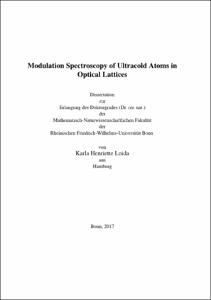Loida, Karla Henriette: Modulation Spectroscopy of Ultracold Atoms in Optical Lattices. - Bonn, 2018. - Dissertation, Rheinische Friedrich-Wilhelms-Universität Bonn.
Online-Ausgabe in bonndoc: https://nbn-resolving.org/urn:nbn:de:hbz:5n-50132
Online-Ausgabe in bonndoc: https://nbn-resolving.org/urn:nbn:de:hbz:5n-50132
@phdthesis{handle:20.500.11811/7524,
urn: https://nbn-resolving.org/urn:nbn:de:hbz:5n-50132,
author = {{Karla Henriette Loida}},
title = {Modulation Spectroscopy of Ultracold Atoms in Optical Lattices},
school = {Rheinische Friedrich-Wilhelms-Universität Bonn},
year = 2018,
month = mar,
note = {In the past fifteen years ultracold atoms confined to optical lattices, which are artificial crystals of light, have proven to be powerful tools in the study of strongly correlated many-body systems widely known from a condensed matter context. The detailed knowledge, high tunability and control of microscopic parameters has enabled the creation and control of highly non-trivial quantum systems for which a direct comparison of model calculations to experimental measurements is now possible. In order to gain precise information on the properties of ultracold gases in optical lattices, many powerful methods have been developed. In particular spectroscopic methods have enabled to probe different characteristic excitations. However, many fascinating properties of strongly interacting quantum many-body systems are not yet fully characterized. Therefore, this thesis explores further possibilities of lattice modulation spectroscopy which is a time-periodic modulation of the optical lattice amplitude. We theoretically investigate the response of different (mostly one-dimensional) cold atom systems to a lattice modulation by means of the time-dependent density matrix renormalization group method and different analytical approximations. In addition to the normal lattice modulation, we consider a superlattice modulation scheme where the lattice amplitude is modulated in a dimerized fashion, coupling to a certain class of excitations in the system. The lattice modulation spectroscopy is a versatile probe which we use to study different situations relevant for experimental applications. We show that a detection of signatures of the exotic bond order wave phase is feasible in a system of interacting fermions on a one-dimensional optical lattice with staggered energy offset. Moreover, we demonstrate that a temperature measurement of fermions confined to an optical lattice is possible as well as a determination of the interaction strength of bosonic atoms confined to a one-dimensional optical lattice. In addition, various excitations in all these systems are investigated in detail.},
url = {https://hdl.handle.net/20.500.11811/7524}
}
urn: https://nbn-resolving.org/urn:nbn:de:hbz:5n-50132,
author = {{Karla Henriette Loida}},
title = {Modulation Spectroscopy of Ultracold Atoms in Optical Lattices},
school = {Rheinische Friedrich-Wilhelms-Universität Bonn},
year = 2018,
month = mar,
note = {In the past fifteen years ultracold atoms confined to optical lattices, which are artificial crystals of light, have proven to be powerful tools in the study of strongly correlated many-body systems widely known from a condensed matter context. The detailed knowledge, high tunability and control of microscopic parameters has enabled the creation and control of highly non-trivial quantum systems for which a direct comparison of model calculations to experimental measurements is now possible. In order to gain precise information on the properties of ultracold gases in optical lattices, many powerful methods have been developed. In particular spectroscopic methods have enabled to probe different characteristic excitations. However, many fascinating properties of strongly interacting quantum many-body systems are not yet fully characterized. Therefore, this thesis explores further possibilities of lattice modulation spectroscopy which is a time-periodic modulation of the optical lattice amplitude. We theoretically investigate the response of different (mostly one-dimensional) cold atom systems to a lattice modulation by means of the time-dependent density matrix renormalization group method and different analytical approximations. In addition to the normal lattice modulation, we consider a superlattice modulation scheme where the lattice amplitude is modulated in a dimerized fashion, coupling to a certain class of excitations in the system. The lattice modulation spectroscopy is a versatile probe which we use to study different situations relevant for experimental applications. We show that a detection of signatures of the exotic bond order wave phase is feasible in a system of interacting fermions on a one-dimensional optical lattice with staggered energy offset. Moreover, we demonstrate that a temperature measurement of fermions confined to an optical lattice is possible as well as a determination of the interaction strength of bosonic atoms confined to a one-dimensional optical lattice. In addition, various excitations in all these systems are investigated in detail.},
url = {https://hdl.handle.net/20.500.11811/7524}
}






